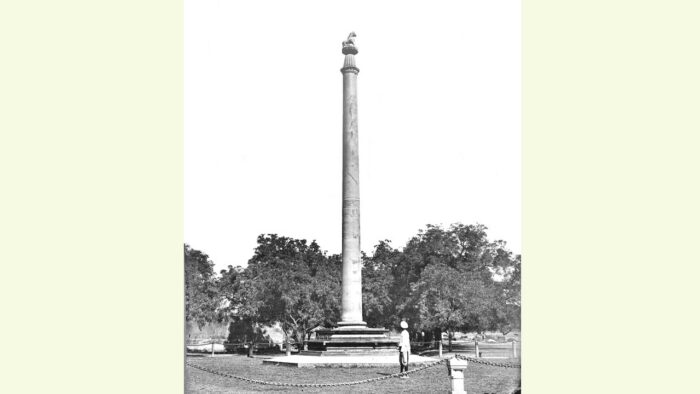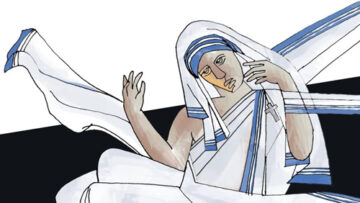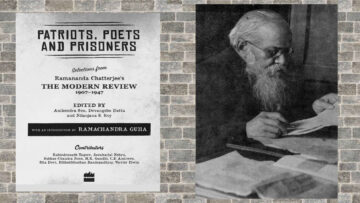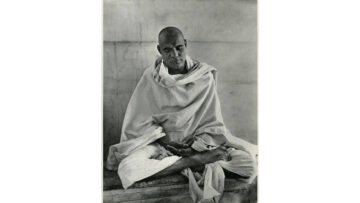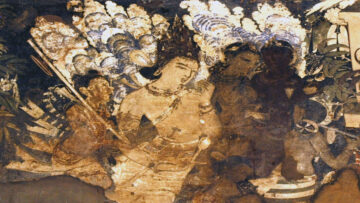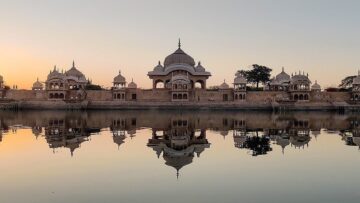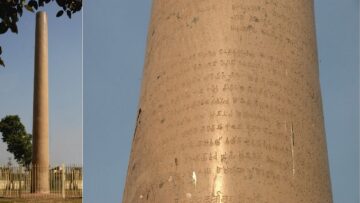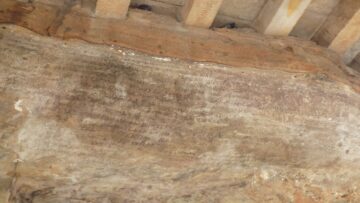The Prayāga Praśasti (also known as the Allahabad Pillar Inscription) was first published in the Journal of the Bengal Asiatic Society in 1834 by Captain A Troye. It was subsequently edited by John Faithfull Fleet and D R Bhandarkar .It is generally agreed upon that this inscription is a posthumous inscription i.e. it was engraved after the demise of Emperor Samudragupta whose feats have been chronicled in the said inscription. Fleet is of the opinion that this inscription was written during the reign of Candragupta II Vikramāditya, the son of Samudragupta. The inscription under discussion was engraved on an Aśokan pillar which is almost 30 feet tall. The pillar was originally located at Kauśāmbī (modern Kosam) on the left bank of the Yamunā. The present location of the pillar is inside the medieval fort at Prayāga and the fort is under the control of the Indian Army. The inscription has been composed in chaste classical Sanskrit. The pillar consists of inscriptions of Aśoka (3rd century BCE) and Jehangir (17th century CE). The Prayāga Praśasti comprises of thirty-three lines although the first two verses are completely illegible. The inscription is a perfect example of a Campu Kāvya i.e. a piece of literature consisting of both verse and prose (padya and gadya respectively). Various metres have been employed in the inscription which up to line 16 is in verse and the rest is in prose. The characters belong to the Gupta Brāhmī alphabet dating to the 4th century CE. The inscription is completely non sectarian and is not dedicated to any deity per say though gods like Śiva and Kubera are referred to therein. The inscription is a Praśasti- meaning a eulogy or high praise of an individual who has accomplished highly difficult tasks. We have examples of earlier eulogies like those of Gautamiputra Satakarni (in the inscriptions of his son Vāsiṣṭhiputra Puḷumavi) and Rudradaman in his Junagadh Rock Inscription of 150 CE. The Prayāga Praśasti of Samudragupta has been authored by Hariśeṇa – the Sandhivigrahika, Kumārāmatya and Mahādaṇḍanāyaka of the Gupta administrative set up and was engraved by Mahādaṇḍanāyaka Tilabhaṭṭaka who meditates at the feet of the Paramabhaṭṭāraka i.e. Samudragupta.
The Gupta Dynasty, as per epigraphical evidence was founded by one Mahārāja Śrīgupta. After the decline of the Kuṣāṇas many independent states emerged in North India, the prominent ones being the Guptas and Nāgas. Mahārāja Śrīgupta was succeeded by his son Mahārāja Ghaṭotkacagupta. Allan identified Śrīgupta with King Che-li-ki-to mentioned in I-tsing’s account (I-tsing was a Chinese pilgrim who visited India in the 7th century CE) who built a monastery at Mrigaśikhavana for Chinese pilgrims. Ghaṭotkacagupta was succeeded by Mahārājādhirāja Candragupta I who was married to Kumāradevī- a Lichchavi princess. This was a political matrimonial alliance and Samudragupta was an offspring of this union. Samudragupta was termed as Lichchavi dauhitra i.e. the son of the daughter of the Lichchavis and it is plausible that he may have inherited the Lichchavi kingdom in Bihar. The Lichchavis were an ancient clan whose antiquity goes right back to the times of the Buddha (6th-5th c. BCE). It is generally assumed that Candragupta I ruled over eastern Uttar Pradesh and Bihar and may have even shared power with the Lichchavis. As far as the domain of the Guptas is concerned the verse mentioned below certainly provides the historian with some noteworthy indications. As per the verse from the Vāyu and Viṣṇu Purāṇas-
Anugaṅgā Prayāgam ca Sāketam Magadhāmstathā |
Etān janapadān sarvān bhokṣyante Guptavamsajāḥ ||
The above verse makes it amply clear that the core of the Gupta Empire consisted of the janapadas of Prayāga on the banks of Gaṅgā River, the city of Sāketa i.e. Ayodhyā and Magadha.
Contents of the Inscription
The Prayāga Praśasti not only comes forth as a document enlisting the personal qualities of Samudragupta but is equally important to understand his political successes as well as the political situation in India around the middle of the 4th c. CE. As per the present author, the poet-laureate Kālidāsa was inspired by this very Praśasti to elucidate in every detail the Digvijaya of Raghu of the Ikṣavāku lineage in his magnum opus Mahākāvya Raghuvaṁśam. The fifth line of the Praśasti declares that Samudragupta was an upholder of the truth of the śāstras. The seventh line describes his accession to the throne –
“Who, being looked at (with envy) by the faces, melancholy (through the rejection of themselves), of others of equal birth, while the attendants of the court breathed forth deep sighs (of happiness), was bidden by (his) father,–who, exclaiming “Verily (he is) worthy,” embraced (him) with the hairs of (his) body standing erect (through pleasure) (and thus) indicative of (his) sentiments, and scanned (him) with an eye turning round and round in affection, (and) laden with tears (of joy), (and) perceptive of (his noble) nature,-[to govern of a surety] the whole world.” The import of this line could be that Candragupta I abdicated in favour of his worthy son Samudragupta as did the kings of the Ikṣavāku dynasty. Samudragupta, in all probability was not the eldest son of Candragupta I but perhaps the king considered it appropriate to make appoint him as his successor because of his virtues. There must have been other royal contenders to the throne and perhaps the most competitive of them all was Kāca, a step brother of Samudragupta. Coins bearing the name of Kāca have been found and they are very similar in design and metrology with the coins of Samudragupta and are closely associated with the latter ̍s coinage. Some historians have conjectured that Kāca may have rose in rebellion against his father ̍s choice of Samudragupta as the heir-apparent. Kāca ̍s coins bear the legend ̍ sarva rājo chchetā ̍, a term applicable only to Samudragupta. Based on this, certain historians have suggested that Kāca and Samudragupta are one and the same person and Kāca was the original name of Samudragupta. More concrete evidence is wanting to establish the identity of Kāca.
The Praśasti presents an extremely systematic account of the conquests of Samudragupta along with the policies that he adopted for every category of the vanquished kings. Politically relevant data begins with line thirteen of the inscription. There are major differences of opinion among scholars with respect to the classification of the conquests of Samudragupta. Some scholars like Vincent Smith and K.P. Jayaswal have suggested that the conquests have been grouped on the basis of geographical factors. Some scholars have attempted to give a chronological categorization to the conquests. But S. R. Goyal differs with both these points of view and in his opinion it is impossible that Samudragupta subdued the kings of Dakṣiṇāpatha without consolidating his position in Āryāvarta.
S.R. Goyal is of the view that the campaigns are organized on the basis of policies followed by Samudragupta. Three kings mentioned in line thirteen were completely uprooted by Samudragupta. Their names were Acyuta, Nāgasena and Gaṇapatināga. These three kings were definitely Nāga kings who had their centers of power at Gwalior and Mathurā. Coins inscribed with the name ̍Acyu ̍ have been discovered at the site of Ahichchhatrā (capital of Uttara Pāñcāla) and a few scholars are inclined to identify this king with Acyuta of the Prayāga Parśasti. Samudragupta also arrested one Koṭakulaja who was the scion of the Koṭa family who in the opinion of S. R. Goyal belonged to modern Bulandshahar in Uttar Pradesh. This ruler or prince has not been accurately identified. Historian Ashvini Agrawal has stated that coins bearing the legend Kota have been found at Sunet and Sanghol in Punjab. After subduing these rivals, Samudragupta is said to have taken pleasure (kriḍata) in the city of Puṣpa. Fleet identifies this city with Pāṭaliputra (known also as Puṣpapura or Kusumapura). Goyal identifies this city with Kānyakubja or modern Kannauj.
Let us now delve into the Peninsular Indian campaigns of Samudragupta which have been systematically delineated in the Prayāga Praśasti. The Praśasti names twelve kings of Dakṣiṇāpatha in all, which were subdued by Samudragupta. One of the reasons behind Samudragupta embarking on war campaigns against these rulers of Dakṣiṇāpatha could be their immense wealth. In addition, having a certain degree of authority over these kings might have enabled Samudragupta to regulate the trade, both inland and maritime of peninsular India. As far as these kings were concerned Samudragupta adopted the policy of grahaṇa-mokṣa-anugraha i.e. to subdue and arrest the kings first and then set them free by showing mercy to them. The data presented in the Praśasti does not indicate the exact number of campaigns Samudragupta led against the kings of Dakṣiṇāpatha and it remains an open ended question where the emperor vanquished all these kings in a single campaign or carried out a series of campaigns against them. Very few North Indian powers could directly control the South Indian powers and this held true even in the medieval times. Samudragupta must have been fully aware of the fact that he could not have completely controlled the kings of Dakṣiṇāpatha and he must have extracted tribute from them while allowing them to rule their own kingdoms. We cannot state for sure whether Samudragupta exercised a nominal political and administrative control over these kings. Moreover these kings, unlike the rulers of Āryāvarta were not a direct threat to the sovereignty of the Imperial Guptas.
The first king to be mentioned among the rulers of Dakṣiṇāpatha is Mahendra of Kosala. Both Ashvini Agrawal and S. R. Goyal are of the opinion that by Kosala it is meant Dakṣiṇa Kosala corresponding to the modern districts Raipur and Bilaspur in Chhatisgarh and Sambalpur in Odisha. The next king is one Vyāghrarāja of Mahākantāra. K P Jayaswal opines that Mahākantāra (Great Forest) is the same as mentioned in the Sabhā Parvan of the Mahābhārata. Kantāraka is supposed to correspond with the modern regions of Bastar and Kanker in modern Chhattisgarh. Vyāghrarāja had been identified with Vyāgrahadeva, a feudatory of the Vākāṭaka ruler Pṛthvisena but not all historians are in agreement with this identification.
Next we come across a king named Mantarāja of Kaurālaka. Fleet happened to read Kairālaka instead of Kaurālaka. L D Barnet identified this region with Khurdā in the Cuttack district of Odisha. Kielhorn while editing the Aihole Inscription of Pulakeśin II remarked that Kaurāla must be the region known as Kurāla which is represented by the lake Kollar between rivers Godāvarī and Kṛṣṇā. H C Raychoudhuri states that the region around the Kollar lake would fall in the territory in Vengi which was the territory of Hastivarman, another king of Dakṣiṇāpatha mentioned in the Praśasti. A copperplate of a king called Narendra of the Sarbhapuriya Dynasty mentions a Mantarājabhukti which might be a region near south Kosala.
Mahendragiri of Piṣṭapura is the next in line of the Dakṣiṇāpatha kings. Fleet thought that the suffix ̍giri ̍ could not be the name of a king but that of one of the Daśanāmi ascetics. However V. S. Ramachandramurti has pointed out that many rulers from Andhra Pradesh used the suffix ̍giri ̍ or ̍adri ̍ (meaning a mountain) after their names. To further add to this argument, the establishment of the Daśanāmi orders of ascetics is attributed to Ādi Śaṅkarācārya who lived in the late 8th and early 9th centuries CE and the inscription under study is dated to the mid 4th century CE. Piṣṭapura is modern Pithapuram, around eighteen kilometres from Kakinada in the East Godāvarī district of Andhra Pradesh. Pithapuram was conquered by Pulakeśin II, the Badami Cālukya ruler in the 7th century CE.
The next ruler is one Svāmidatta of Koṭṭura. Koṭṭura is a very common name in South India. According to some scholars, the Koṭṭura referred to in the Prayāga Praśasti is the one near Parlakimedi in the Ganjam district of Odisha. Svāmidatta has not been identified. Next comes a king called Damana of Eraṇḍapalla. Fleet identified this site with Erandol in Khandesh in Maharashtra and a few Gupta period remains have been found here. Dubreuil identified it with Erandapali near Śrikākulam whereas G Ramdas identified it with Yendipalli in Visakhapattanam district or Endapalli in the West Godāvarī district, both in Andhra Pradesh. K P Jayaswal places Eraṇḍapalla in Kalinganagara (modern Mukhalingam) also in the state of Andhra Pradesh. The next king to be mentioned was Viṣṇugopa, a prominent ruler of Kāñci or Kāñcipuram, the temple town in Tamil Nadu and the erstwhile capital of the Pallavas. Viṣṇugopa undoubtedly belonged to the house of the mighty Pallavas. He was the younger brother of Siṁhavarman and the son of Skandavarman II. He enjoyed the position of Yuvāmaharaja during the reign of his brother and acted as the regent to his (Viṣṇgopa ̍s) nephew Skandavarman III. Samudragupta’s attack may have taken place during the regency of Viṣṇugopa.
The Praśasti next makes a reference to one Nīlarāja of Avamukta. H. C. Raychoudhuri suggested that an old seaport named Nilapalli in the Godavārī district may have some connection with Nīlarāja. He refers to the temple of Avamukteśa in the Anantpur district of Andhra Pradesh. Avimukteśa is a name of Lord Śiva and the holy city of Kāśī and its immediate environs are designated as Avimuktakṣetra. We have no way to ascertain whether the Avamukta of the Prayāga Praśasti had any correlation with Kāśī. Jayaswal has tried to identified Avamukta with Ava mentioned in Kharaveḷa’s Hathigumpha Inscription. Considering these highly divergent opinions, the site of Avamukta has not been satisfactorily identified.
Hastivarman of Vengi is mentioned next in the Prayāga Praśasti. Vengi has been identified with Peddavegi in the Krishna district of Andhra Pradesh and includes the entire coastal region between rivers Godavārī and Kṛṣṇā where roads from Kaliṅga, Draviḍa, Karnataka, Maharashtra and Kosala met. Hastivarman was a king who hailed from the Śālankāyana Dynasty of Vengi. Vengi was later held by the Pallavas, Viṣṇukuṇḍins and Cālukyas.
Ugrasena of Palakka follows Hastivarman in the list of the kings of Dakṣiṇāpatha. Vincent Smith identified Palakka with Palghat in Kerala but later revised his view and agreed with V Venkayya that it should be in the Nellore district of Andhra Pradesh. J Dubreuil identifies it with Palakkada mentioned in many Pallava grants (E.g. Yuvāmahārāja Viṣṇugopavarman’s grants). Palakka in all probability was a Pallava vice-royalty under a Pallava prince whose correct name was Ugravarman.
Kubera of Devarāṣṭra is the next king who features in the list under discussion. Fleet identified Devarāṣṭra with Maharashtra. Dubreuil identified it with a place in the Vishakhapattanam district of Andhra Pradesh. According to Ashvini Agrawal, Devarāṣṭra must have been somewhere in the coastal region between the mouths of the Mahānadī and Godāvarī. In the opinion of Y. R. Gupte, Devarāṣṭre a village in the Satara district of Maharashtra and a Śivalingam there is called Samudresvara. This Śivalingam may be preserving the memory of the conquest of Emperor Samudragupta ̍s conquest of Devarāṣṭra.
The last king to be mentioned in the given list is Dhananjaya of Kusthalapura. Vincent Smith regarded Kusthalapura as a variant of Kusasthalapura which is an alternative name for the city of Dvārakā in Gujarat. However, Samudragupta’s campaign was restricted to eastern Deccan and did not cover Gujarat. In addition, Gujarat was never counted as a part of Dakṣiṇāpatha. B V Krishnarao identified it with the modern town of Kolorupak or Kollipak situated on the river Aleru in Andhra Pradesh. Chieftains of Kot (ancient Dhānyakaṭaka) trace their origin from a certain Dhananjaya who could be identified with this king.
Some scholars like Dubreuil are of the opinion that Samudragupta attained limited success in Dakṣiṇāpatha and was opposed by a confederacy of kings of Dakṣiṇāpatha. However, the evidence from the Prayāga Praśasti does not support this view.
To further understand Samudragupta ̍s policy towards the kings of Dakṣiṇāpatha, let us consider the three kinds of conquerors enlisted by Kauṭilya:
- Dharmavijayi- who neither takes the kingdom nor the riches of the defeated king, spares his life but makes him accept the suzerainty of the victor.
- Lobhavijayi – takes away the riches of the defeated king but spares his life.
- Asuravijayi – captures the territory of the defeated king and does not spare his life.
Samudragupta comes close to a Dharmavijayi and we have already seen that he adhered to the policy of grahaṇa- mokṣa anugraha as far as the kings of Dakśiṇāpatha are concerned. We may surmise that Samudragupta may have received some kind of a tribute from the kings of Dakśiṇāpatha as a mark of their acknowledging the nominal authority of Samudragupta. Emperor Raghu of the Ikṣavāku dynasty in the Raghuvaṃśam restores the kingdom of the lord of Mahendra (grihita- pratimukta) during his digvijaya. We shall discuss more on this and the remaining conquests of Samudragupta in the next article.
References
- Agrawal, Ashvini. Rise and Fall of the Imperial Guptas. Delhi: Motilal Banarasidass, 1989.
- Fleet, J F. Inscriptions of the Early Gupta Kings and their Successors, Corpus Inscriptionum Indicarum, Volume III. Varanasi: Indological Book House, 1960 (Third Revised Edition)
- Goyal, S R. History of the Imperial Guptas. Allahabad: Allahabad Central Book Depot, 1967.
- Kangle R.P (Trans.), Kautiliya Arthashastra., Mumbai: Maharashtra Rajya Sahitya Sanskruti Mandal, 2011(Reprint)
Feature Image Credit: wikipedia.org
Disclaimer: The opinions expressed in this article belong to the author. Indic Today is neither responsible nor liable for the accuracy, completeness, suitability, or validity of any information in the article.

